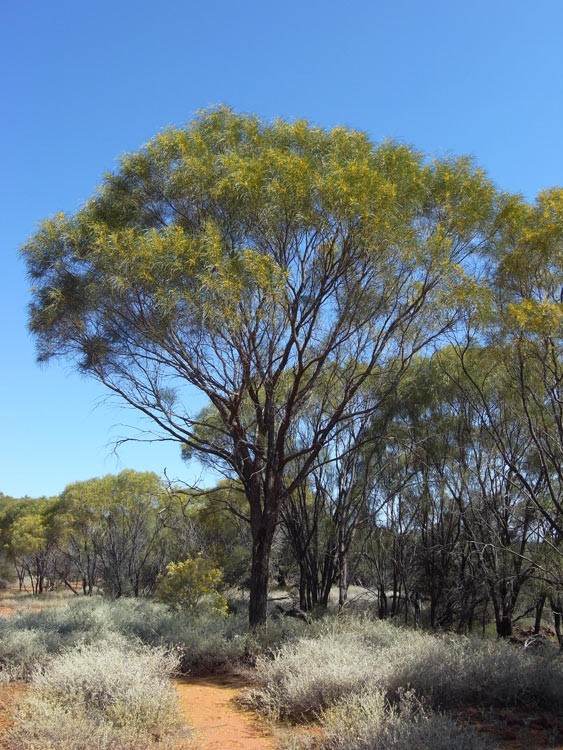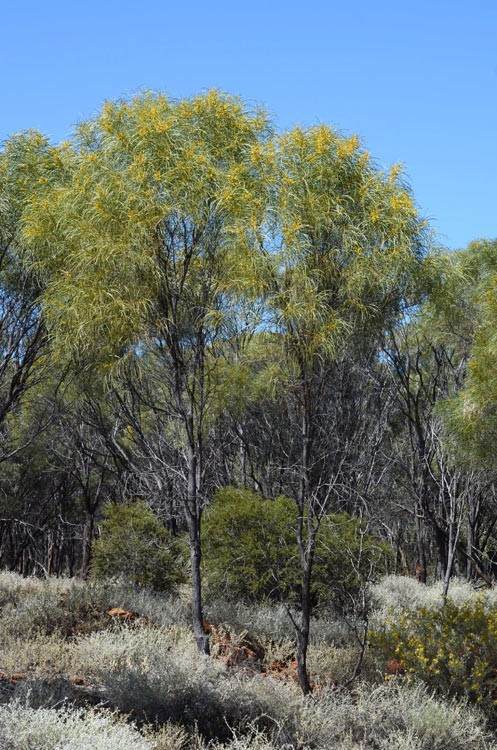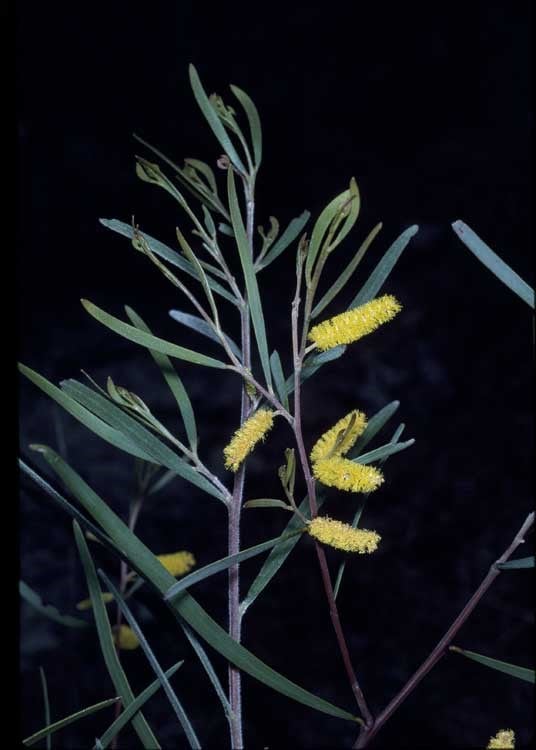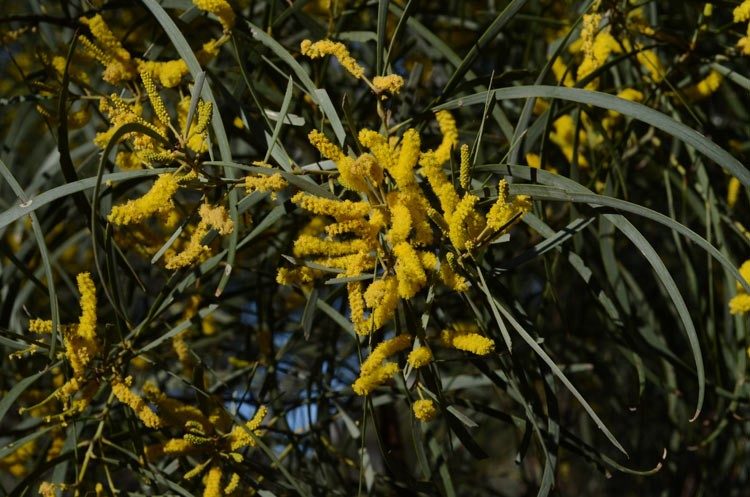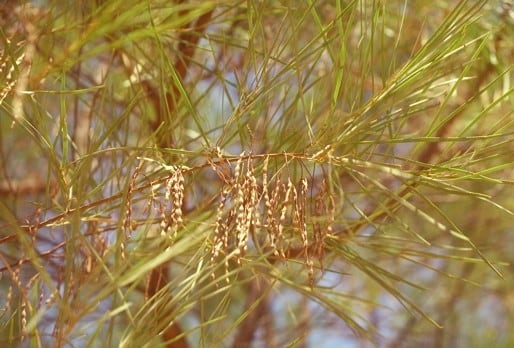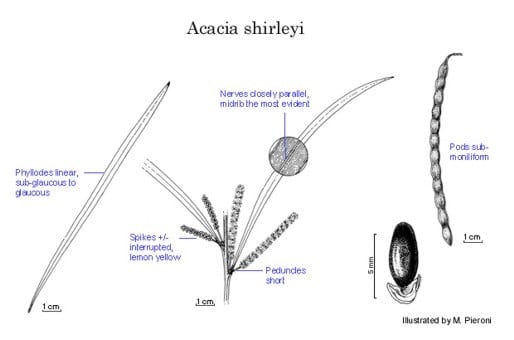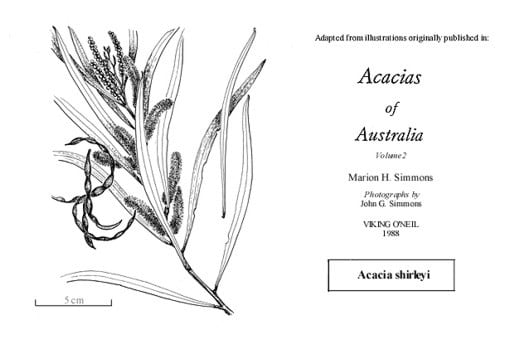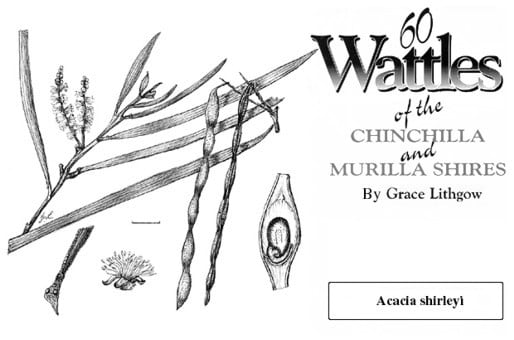Acacia shirleyi Maiden
WATTLE
Acacias of Australia
Common Name
Lancewood
Family
Fabaceae
Distribution
Common in semi-arid and temperate areas of inland north-eastern Australia from N of Toowoomba, Qld, to Victoria R., N.T.
Description
Tree to 15 m high, single-stemmed, umbrella-shaped, sometimes a shrub. Bark almost stringy, dark grey to black. Branchlets angular, light brown or yellowish brown, sometimes pruinose, glabrous, resinous or mealy. Phyllodes linear to narrowly elliptic, ±straight or recurved, flat, (8–) 10–19 (–22) cm long, 2–9 (–11) mm wide, coriaceous, slightly pruinose or sometimes partly brownish tinged, glabrous, with subprominent midnerve; minor nerves (8–) 10–14 per mm, inconspicuous, parallel, not anastomosing; gland 1, rudimentary, basal. Spikes 1.5–5 (–6) cm long, ±interrupted, lemon-yellow. Flowers 5-merous; calyx 0.5–0.8 mm long, dissected to 1/5–1/4, densely hirsute; corolla 1.5–1.9 mm long, dissected to 1/2, glabrous; ovary densely pubescent. Pods linear, constricted between and raised over seeds, straight to shallowly curved, 6–12 cm long, 3.5–6 mm wide, crustaceous and rather brittle, longitudinally wrinkled, glabrous. Seeds longitudinal, broadly elliptic, 4–5.5 mm long, black; pleurogram without halo; areole open.
Phenology
Flowers mostly early Mar.–late May in N.T., late Apr.–mid-July in Qld.
Habitat
Grows often in dense stands, also in closed forests, low open forests or mixed savannah woodlands, in shallow gravelly or skeletal sandy soils on sandstone or laterite.
Specimens
N.T.: 5 miles [8 km] E No. 11 bore, Murranji S.R., 17 July 1956, G.Chippendale (DNA, NSW); 2 miles [3.2 km] N [of] Newcastle Waters Ck, Stuart Hwy, J.R.Maconochie 969 (DNA, NSW); 4.5 km S of King R. Crossing, Stuart Hwy, M.D.Tindale 6067 & C.Dunlop (NSW, UNSW). Qld: 21.4 km from Torrens Ck to Pentland, N.Hall H83/46 (NSW); W scarp of Cory road, c. 45 miles [72 km] SW of Winton, I.V.Newman 497 (BRI, K, NSW).
Notes
The more southerly distributed W.A. endemic, A. distans, is probably related to A. shirleyi. Although Acacia catenulata was included in the A. aneura (Mulga) complex by L.Pedley, Trop. Grasslands 7: 4 (1973) it is probably more closely related to A. shirleyi.
Known to hybridise with Acacia rhodoxylon in Queensland. Details of ecology, utilisation etc. are given in J.W.Turnbull (ed.), Multipurpose Austral. Trees & Shrubs 194 (1986).
FOA Reference
Data derived from Flora of Australia Volumes 11A (2001), 11B (2001) and 12 (1998), products of ABRS, ©Commonwealth of Australia
Author
Minor edits by B.R.Maslin & J.Rogers
Dr M.D.Tindale and Dr P.G.Kodela with the assistance of M.Bedward, S.J.Davies, C.Herscovitch, D.A.Keith and/or D.A.Morrison
This identification key and fact sheets are available as a mobile application:
URL: https://apps.lucidcentral.org/wattle/
© Copyright 2018. All rights reserved.

